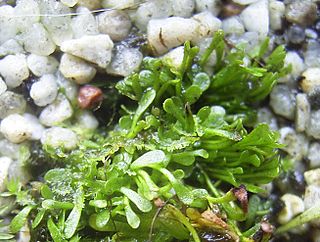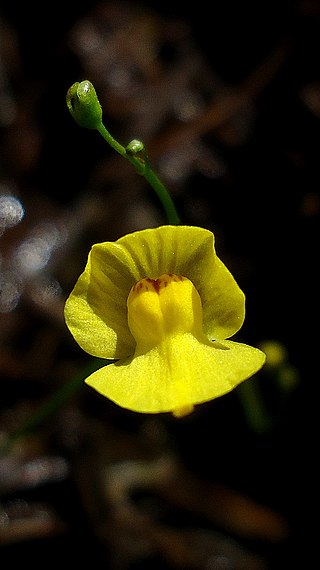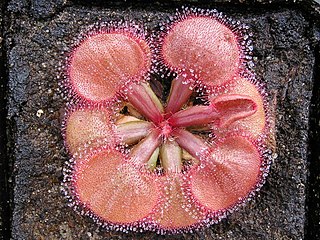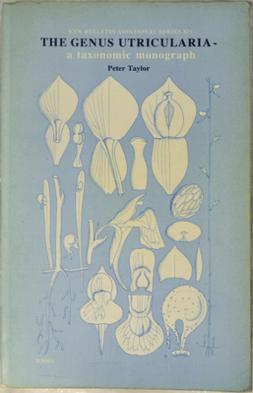
Droseraceae is a family of carnivorous flowering plants, also known as the sundew family. It consists of approximately 180 species in three extant genera. Representatives of the Droseraceae are found on all continents except Antarctica.

Utricularia, commonly and collectively called the bladderworts, is a genus of carnivorous plants consisting of approximately 233 species. They occur in fresh water and wet soil as terrestrial or aquatic species across every continent except Antarctica. Utricularia are cultivated for their flowers, which are often compared with those of snapdragons and orchids, especially amongst carnivorous plant enthusiasts.

Genlisea aurea is one of the largest carnivorous species in the genus Genlisea. It has pale bundles of root-like organs up to about 15 cm long under ground that attract, trap, and digest protozoans. These organs are subterranean leaves, which lack chlorophyll. G. aurea is endemic to Brazil, where it grows with several other species of Genlisea. It possesses an exceptionally small genome for a flowering plant.

Drosera binata, commonly known as the forked sundew or fork-leaved sundew,Carnivorous Plants of New Zealand. Ecosphere It is a large, perennial sundew native to Australia and New Zealand. The specific epithet is Latin for "having pairs" - a reference to the leaves, which are dichotomously divided or forked.

A protocarnivorous plant, according to some definitions, traps and kills insects or other animals but lacks the ability to either directly digest or absorb nutrients from its prey like a carnivorous plant. The morphological adaptations such as sticky trichomes or pitfall traps of protocarnivorous plants parallel the trap structures of confirmed carnivorous plants.
Barry Rice is an American botanist, professional carnivorous plant grower and the author of the book Growing Carnivorous Plants. Barry Rice maintains the website Sarracenia.com and has a detailed FAQ on many carnivorous plant topics. He is co-editor of the International Carnivorous Plant Society's journal, the Carnivorous Plant Newsletter. He also works as an invasive species specialist under the Global Invasive species Team. Currently, he is focusing his research on Utricularia and its distribution in the western states. Another project that he also works on is the pollination of Darlingtonia californica.

Utricularia gibba, commonly known as the humped bladderwort or floating bladderwort, is a small, mat-forming species of carnivorous aquatic bladderwort. It is found on all continents except Antarctica.

Utricularia resupinata, popularly known as lavender bladderwort or northeastern bladderwort, is a small perennial subaquatic carnivorous plant that belongs to the genus Utricularia. It is native to eastern Canada, the United States, and Central America. This plant species has an interesting etymology, growth pattern, ecology, and research history. As a plant that is threatened or endangered in many of the States where it is found, it is a candidate for sound conservation efforts.
Colura zoophaga is a species of epiphytic liverwort that is endemic to the African highlands, specifically parts of Kenya. It belongs to the genus Colura, which has been hypothesized to be carnivorous as early as 1893. It is a recently described species that was the subject of the first scientific study aimed at investigating the allegations of carnivory in liverworts.
Peter Geoffrey Taylor (1926–2011) was a British botanist who worked at Royal Botanic Gardens, Kew throughout his career in botany. Taylor was born in 1926 and joined the staff of the herbarium at Kew in 1948. He published his first new species, Utricularia pentadactyla, in 1954. In 1973, Taylor was appointed curator of the orchid division of the herbarium and, according to Kew, "under his direction, orchid taxonomy was revitalised and its horticultural contacts strengthened."

Carnivorous plants are plants that derive some or most of their nutrients from trapping and consuming animals or protozoans, typically insects and other arthropods, and occasionally small mammals and birds. Carnivorous plants still generate some of their energy from photosynthesis. Carnivorous plants have adapted to grow in places where the soil is thin or poor in nutrients, especially nitrogen, such as acidic bogs. They can be found on all continents except Antarctica, as well as many Pacific islands. In 1875, Charles Darwin published Insectivorous Plants, the first treatise to recognize the significance of carnivory in plants, describing years of painstaking research.

Mary Adelia Davis Treat was a naturalist and correspondent with Charles Darwin. Treat's contributions to both botany and entomology were extensive—six species of plants and animals were named after her, including an amaryllis, Zephyranthes treatae, an oak gall wasp Bellonocnema treatae and three ant species Aphaenogaster mariae, Aphaenogaster treatae, and Dolichoderus mariae.

Insectivorous Plants is a book by British naturalist and evolutionary theory pioneer Charles Darwin, first published on 2 July 1875 in London.

Drosera falconeri is a carnivorous plant in the genus Drosera. It is endemic to the Northern Territory of Australia.

"An account of Nepenthes in New Guinea" is a monograph by Matthew Jebb on the tropical pitcher plants of New Guinea. It was published in the March 1991 issue of Science in New Guinea, a journal of the University of Papua New Guinea. It remains the only major monograph devoted to the tropical pitcher plants of the island.

The Insectivorous Plant Society, often abbreviated as IPS, is an organization based in Chiyoda, Tokyo, Japan. Founded in November 1949, it is likely the oldest carnivorous plant society in the world. It celebrated its 50th anniversary in November 1999 at the Diamond Hotel in Tokyo. The society is named after Charles Darwin's 1875 book, Insectivorous Plants.

The Genus Utricularia: A Taxonomic Monograph is a monograph by Peter Taylor on the carnivorous plant genus Utricularia, the bladderworts. It was published in 1989 by Her Majesty's Stationery Office (HMSO) as the fourteenth entry in the Kew Bulletin Additional Series. It was reprinted for The Royal Botanic Gardens, Kew in 1994.

The Carnivorous Plants is a major work on carnivorous plants by Barrie E. Juniper, Richard J. Robins, and Daniel M. Joel. It was published in 1989 by Academic Press. Much of the book was written by the three authors over an eight-year period at Oxford University's Botany School.
Rebecca Merritt Smith Leonard Austin was a botanist and naturalist who collected and sold native plants in California and Oregon. Lomatium austiniae and Cephalanthera austiniae are named in her honor. She studied the chemistry, natural history of, and insects captured by the carnivorous pitcher plant Darlingtonia californica, and sold collected specimens to botanists and collectors. Her specimens are included in the collections of the Smithsonian Institution and the California Academy of Sciences.















